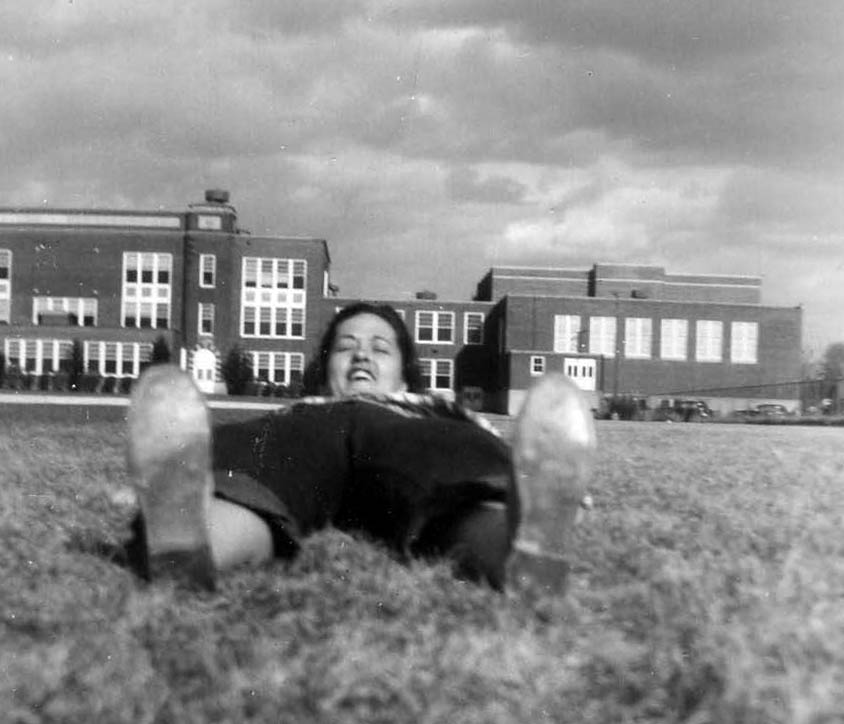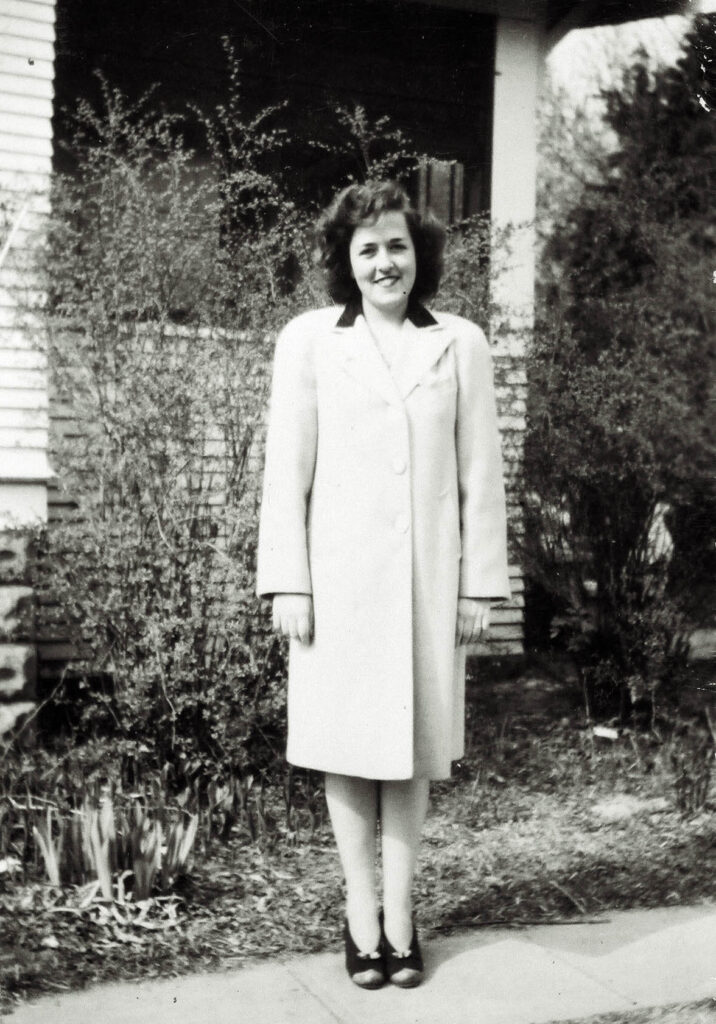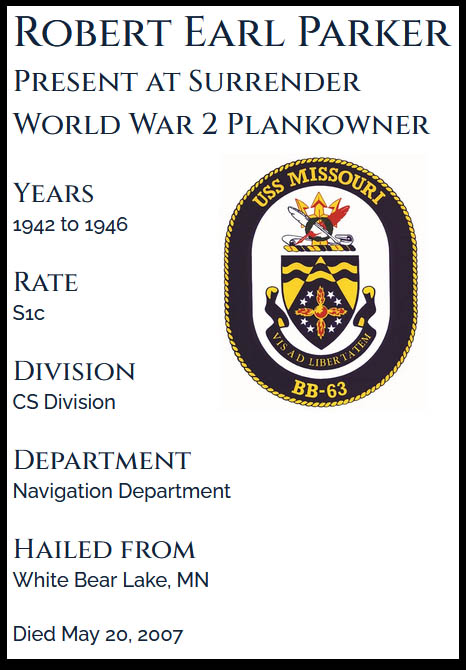Both Marguerite and Bob attended White Bear High School. Bob was already a junior when Marguerite entered high school as a freshman in the fall of 1941.

Bob is in the 4th row, 2nd from the left.

Bob is off to the right, next to the arrow. This would be his last class photo.

Marguerite is in the top row, 2nd from the left.
I find it interesting that when Marguerite started her freshman year in the fall of 1941, her brother Jack was starting his sophomore year and her sister Leona her senior year.


Marguerite is off to the right, below the arrow.
Here are some other pictures of Marguerite during her high school years.






Reed Oil Company on Fourth Street is off to the left.






She sure makes a great hula dancer!

Bob registered for the World War II draft about 3 weeks after his 18th birthday.16 On November 10, 1942, a little over 2 months into his senior year in high school, Bob enlisted in the Navy.17 He, like many young men during that time, would not get to graduate from high school or share memories with his friends of all the good times they had during their senior year.

A farewell note to Bob, from a neighbor, was published in the paper. The neighbor wrote it for Bob, but the feeling expressed was one held by the entire country. The note read “The earnest desire of our young men like Bob to voluntarily place themselves in our country’s service is one of the major reasons why it is right that victory will be ours. Good luck, Bob, and the best wishes of your family and many friends go with you.”
I didn’t find many records for Bob’s military history, but I found enough. Bob entered the Navy on November 10, 1942 and left on January 9, 1946. After boot camp he served on the U.S.S. Custer (APA-40) under Captain Ralph Edward Hansen from July 17, 1943 through April 1944. He then transferred to the U.S.S. Missouri (BB-63) where he served from June 10, 1944 to January 9, 1946.


The history of the battleship Missouri, also known as the “mighty MO,” is well documented. The battleship was built at the Brooklyn Naval Yard and it was the last one built by the United States Navy. The ship was commissioned on June 11, 1944 and Bob was a “plankowner,” which means that he was a member of the crew when the ship was placed in commission. He served throughout the remainder of WWII aboard the Missouri.18

The ship was 887 feet long (3 football fields) and was capable of in excess of 33 knots (about 38 miles per hour).
Bob’s rank was Seaman 1st class (S1c) and he was a signalman, a person who specialized in visual communication, such as flag semaphore, visual Morse code and flag hoist signaling. The job of a signalman no longer exists in the Navy.

By August 1944 the ship was in the Gulf of Paria, near Trinidad and Tobago, participating in drills and battle practice. From there it traveled through the Panama Canal to Pearl Harbor where it was moored over Christmas of 1944. In January 1945 the ship and its crew joined the war, which included air strikes against Tokyo as well as supporting the invasion of Iwo Jima and Okinawa.
On May 8, 1945 Victory in Europe (V-E Day) was declared, but the war raged on in the Pacific Theater. It was also in May 1945 that Admiral William F. Halsey Jr. became the Commander of the Third Fleet and the Missouri became his flag ship. Under his command the battle of Okinawa continued. It ended 81 days after it began, with a loss of 12,520 Americans and 110,000 Japanese. The Missouri and its crew had continuously been in support of the Okinawa Campaign for almost 3 months.
While in battle, the crew of the Missouri did a great job defending their ship. Only once did a kamikaze pilot get past the defenses and crash into the deck of the ship. The damage done was superficial and no men were injured.
On August 6, 1945, from 70,000 to 135,000 people were killed when the first atomic bomb was dropped on Hiroshima. Three days later the second atomic bomb was dropped on Nagasaki killing between another 60,000 to 80,000 people.
Less than a week later on August 15, 1945 Emperor Hirohito announced his country’s surrender. The news of the surrender spread around the world, Victory in Japan, V-J Day, was declared.
On September 2, 1945, while anchored in Tokyo Bay, the formal surrender agreement was signed in a ceremony held on the quarterdeck aboard the battleship Missouri.19 Bob, as a member of the crew, was present as a witness to the historic event.


Allied officers & crew crowd decks of the American battleship Missouri as senior Japanese delegate Mamoru Shigemitsu signs official surrender documents ending WWII; other Japanese delegates, include grim Gen. Yoshijiro Umezu (front row, alone)

Bob was discharged from the service January 9, 1946. He had served a little over 3 years.20
Many men left school to serve their country during World War II. The women left behind also served, by taking jobs that before the war they would not have had the opportunity to try. Marguerite was one of those women. She applied with the Northern Pacific Railway Company to work during the summer of 1943. As a 16 year old minor, her mother had to sign in order for her to take a job. Marguerite was hired on June 1, 1943 to work as a substitute slip sorter in the car accounting department at a rate of $3.68; I assume it was an hourly rate, but it may be a daily rate.21


Notice that at the very top it states that “Applicants for employment will be required to show five years previous occupation…” There was a definite work force shortage since Marguerite listed no work history, yet she was hired. She gave her principal and her priest as her general references and the 3 other references listed are 2 White Bear businessmen and her uncle, Lewis Heckel. Finally, she signed the application using Margaret instead of Marguerite.
Marguerite held the slip sorter job through September 4, 1943 when she returned to school to start her junior year.22

Bob did not finish his education, but Marguerite graduated from White Bear High School in 1945 at 18 years old.

Notice that she signed Margueritte with 2 t’s instead of Marguerite.
TO BE CONTINUED…
Thanks for visiting, come back soon,
Cynthia
© 2024 Copyright by Cynthia Vadnais, All Rights Reserved
Footnotes for Marguerite Marie Vadnais and Robert Earl Parker (Part 2 of 3) post
